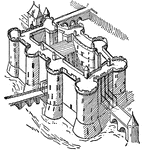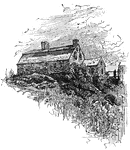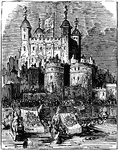Prisons and Punishments
The Prisons and Punishments ClipArt gallery offers 50 illustrations of jails and other forms of punishment such as the pillory or dunking stool.

Bastile
"The taking of the Bastile, July 14, 1789. The Parisian mob, not satisfied with the formation of the…

Bastile Key
"Key of the Bastile. This key of the old Paris prison known as the Bastile, was sent by La Fayette to…

Bastille
The Bastille, a fortress-prison in Paris remembered by the storming of the Bastille in the French Revolution.

Beheading of John the Baptist
"And when a convenient day was come, that Herod on his birthday made a supper to his lords, and the…

Brank
"Brank, or Branks, an instrument and formerly used in Scotland, and to some extent also in England,…

Prison Pen at Columbia
"Appearance of the prison pen at Columbia, S. C., on the arrival of Sherman's army."— Frank Leslie,…

Confederate Prison Camp
"The Confederate Prison camp at Belle Isle, James River, Va."— Frank Leslie, 1896

Dartmoor Prison
HM Prison Dartmoor is located in Princetown, high on Dartmoor in the English county of Devon. Its high…

Ducking Stool
Used as a form of humiliating punishment for angry women, a ducking stool was "a stool or chair in which…

Ducking-Stool
"An apparatus at one time in use in Britain for the punishment of wives. The ducking-stool grew out…

Ducking-Stool
"1. Tumbrel preserved at Leominster; 2. Ducking-chair in the museum at Scarborough." — Chambers'…

Guillotine
An illustration of a guillotine which was a device used to carry out executions by decapitation. Guillotines…

Guillotine
"The guillotine was used during the Reign of Terror of the French Revolution. Now that the power of…

Guillotine
"The guillotine is an apparatus for beheading persons at one stroke, adopted by the National Assembly…

Guillotine
The guillotine was a decapitating execution device invented by Joseph-Ignace Guillotin, remembered for…

Guillotine
The guillotine was a device used for carrying out executions by decapitation. It consists of a tall…

Guillotine
The guillotine was a device used for carrying out executions by decapitation. It consists of a tall…

Handcuff
A fastening consisting of an iron ring around the wrist, usually connected by a chain with one on the…

The Jersey Prison Ship
One of the prisons used by the British at New York during the American Revolutionary War.

Lollard Prison, Lambeth Palace
Lambeth Palace is the official London residence of the Archbishop of Canterbury. It is located in Lambeth,…

Interior of Libby Prison
"Interior of Libby Prison, Richmond, Va., with prisoners from General Lee's army confined after the…

Libby Prison, Richmond
Libby Prison was a Confederate Prison at Richmond, Virginia, during the American Civil War.

The Old Jail at York
The gaol was a colonial prison building for York County, Maine and served as a jail from 1719 to 1879.

Arkansas State Penitentiary
An illustration of Arkansas State Penitentiary as pictured in 1874. The prisoners housed were the main…

Peter Delivered from Prison by an Angel
"And, behold, the angel of the Lord came upon him, and a light shined in the prison: and he smote Peter…

Pillory
A wooden frame designed for the punishment of offenders and criminals. This mode of punishment was formerly…

Pillory
A frame of wood erected on a post or pole, with movable boards resembling those in the stocks, and the…

Prison
"The humors of a prison- scene in a station-house cell, Washington, D. C., after the appointment of…

Gratiot Street Prison
The Gratiot Street Prison was an American Civil War prison located in St. Louis, Missouri and was the…

Prisoner Drilling Hole
An illustration of a prisoner drilling a hole in the wall of his prison cell.

Provost Jail
The New Jail was made a Provost Prison during the Revolutionary War and here officers and men of note…

Safe Bind, Safe Find
"A rogue is caught - if him you'd safely find, / Fetter each limb, and then securely bind. / Dealing…

Ducking Stool
"A Ducking Stool is a chair in which scolding and vixenish wives were formerly securely fastened, to…

Sugar House in Liberty Street
Perhaps the worst of all the New York prisons during the American Revolution was the third Sugar House,…

Procession to the Tower of London
Her Majesty's Royal Palace and Fortress, more commonly known as the Tower of London (and historically…

Traitor's Gate, Tower of London
The name Traitors' Gate has been used since the early seventeenth century, prisoners were brought by…

Walnut Street Prison
"The Walnut Street Prison. This edifice was erected in 1774, and taken down in 1836. The beautiful new…












